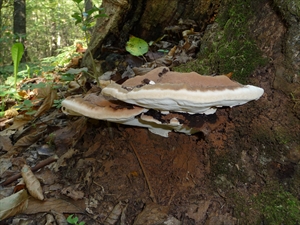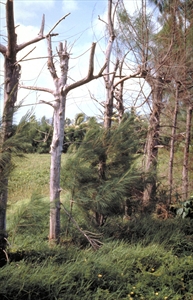Casurina butt rot. Also see Fact Sheet no. 004 for butt and root rots of other trees.
Pacific Pests, Pathogens, Weeds & Pesticides - Online edition
Pacific Pests, Pathogens, Weeds & Pesticides
Casuarina butt rot (195)
Ganoderma applanatum. The fungus was previously known as Fomes applanatus. The common name for the fungus is the Artist's Conk.
Asia, North and South America, Europe, Oceania. It is recorded from Australia, Cook Islands, Federated States of Micronesia, Fiji, New Caledonia, Palau, Papua New Guinea, Tuvalu, and Samoa. The collection of specimens from Solomon Islands may be Ganoderma australe, which causes a heart rot of living trees.
The fungus is a common cause of decay and death of Casuarina, and many other species of trees, e.g., acacias, eucalyptus, beech, and some conifers, such as Douglas fir.
The fruit body is greyish-brown, bumpy, with rings, often powdered brown from the release of spores, with a white underside (Photos 1&2). It produces a new fertile layer on the underside of the fruit body each year; the layer has millions of white pores, inside of which the spores are formed. Fruit bodies can grow for 5-10 years, and reach up to 50 cm across and 10 cm deep, although often they are much smaller.
External symptoms on infected trees are difficult to detect. The growth of trees may be slower, dieback present and, on broadleaf trees, leaves may turn yellow.
Often the trees take many years to die, but they become very susceptible to blowing over in the wind, and therefore a danger to people and property. Ganoderma is especially common on broadleaved trees, although it is also often seen on Casurina.
The fungus spreads in the soil by root-to-root contact causing a root, butt and trunk rot on susceptible species. Spread is also thought to occur via windborne spores with infection through wounds.
The fruit body is inedible as it is too woody.
Infected trees die back and are eventually killed (Photo 3). The fungus attacks the heartwood in roots, butts and trunks, but it can also feed on the sapwood, the living tissues of the trunk. The fruiting bodies or fructifications of the fungus occur on dead and living trunks and branches of standing and fallen trees. The fungus occurs on a wide range of woody plants causing a white heart rot.
Look for the reddish-brown flat fruit bodies, without stalks, attached to the butt or trunk over most of their width. Look for the white pore surface underneath the fruit body which is easily bruised. The fruit body is sometimes called the 'artist's conk' because a picture (or a message) can be drawn on the underside, and when it dries it turns brown. Place a sheet of paper under the fruit body to collect the spores. The spore print is brown.
CULTURAL CONTROL
There is no control for Ganoderma butt rot. Once a tree is infected it will die, although this may take several years. When brackets are seen, it is best to remove the tree to prevent infection of trees nearby, and also to prevent potential damage to property or people should the tree, or a branch, fall in the wind.
Wounding of trees should be avoided to reduce the chance of infection.
CHEMICAL CONTROL
There is no appropriate chemical control for this disease.
AUTHOR Grahame Jackson
Information from Kuo M (2018) Ganoderma applanatum. Retrieved from the MushroomExpert.Com Web site. (http://www.mushroomexpert.com/ganoderma_applanatum.html). and from Ganoderma applanatum. Wikipedia. (https://en.wikipedia.org/wiki/Ganoderma_applanatum). and from CABI (2019) Ganoderma applanatum (shelf fungus). Crop Protection Compendium. (Kuo, M. (2018, October). Ganoderma applanatum. Retrieved from the MushroomExpert.Com Web site: http://www.mushroomexpert.com/ganoderma_applanatum.html). Photos 1&3 Kohler F, et al. (1997) Diseases of cultivated crops in Pacific Island countries. South Pacific Commission. Pirie Printers Pty Limited, Canberra, Australia. Photo 2 Wikipedia: Ganoderma applanatum. (http://en.wikipedia.org/wiki/Ganoderma_applanatum).
Produced with support from the Australian Centre for International Agricultural Research under project PC/2010/090: Strengthening integrated crop management research in the Pacific Islands in support of sustainable intensification of high-value crop production, implemented by the University of Queensland and the Secretariat of the Pacific Community.






